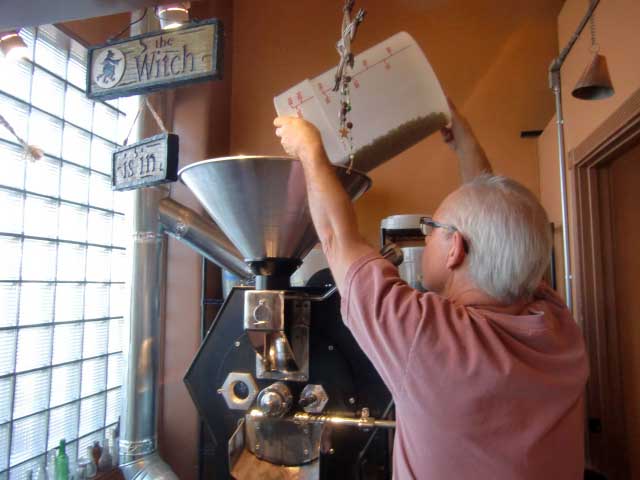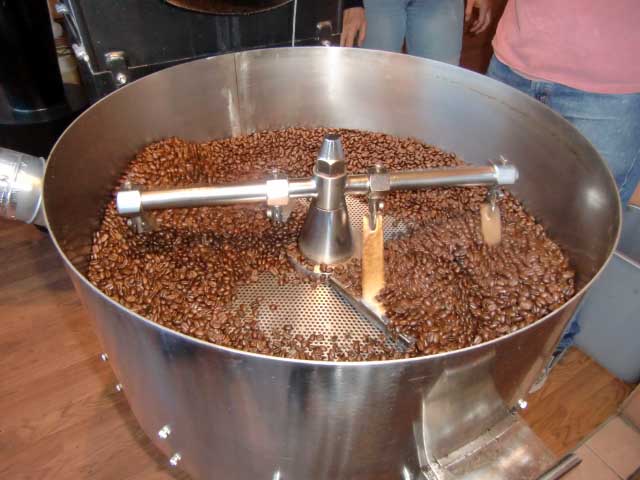Love great coffee? Support sustainable organic farming? Feeling adventurous? Follow us from the rain forests of Peru to your local coffee shop as we chronicle the lives of Real People, Really Good Coffee…
Real People, Really Good Coffee – Part 2
For Real People, Really Good Coffee Part #1 click here.
Modern Coffee Shipping
Today, as crops are harvested in the farm regions of Peru, the majority is shipped via smaller truck oftentimes to Lima or depending on the location, to larger Provincial cities. Many of these trucks are operated by larger companies, however the majority of produce is still delivered by smaller operations based in whatever place is central for delivery from the outlying farms & ranches in the mountains.
In the coffee industry, the coffee is most often purchased by small and medium sized coffee middleman who consolidate batches for larger corporate buyers. The coffee cooperatives are non profits that exist to improve the economic condition for the myriad small farmers that pool their crops and are able to obtain a better price than from the coffee wholesalers. The coops typically endeavor to educate and assist these small growers.
From the agricultural centers to Lima, coffee travels over the Andes and to the coast where it is to be further processed. The coffee is peeled to remove the parchment “shell” & the resulting green coffee beans are then bagged and weighed. All taxes must be paid, and a clear paper trail must be created.
The next step from Peru is to deliver the coffee to “aduanas” (customs,) where it will be inspected & re-weighed, and all paperwork reviewed. Then the cargo is assigned to a ship and loaded for delivery from the port of Callao to Long Beach, Ca. To expedite, we use a company called Skynet who helps navigate this part of the process. You’ll meet Guiliana & Rafael who were not only kind, but patient as well with us when we were neophytes.
In the Port of Callao, the coffee will be loaded, filling the ubiquitous containers that move everything today. One container can hold 42,000 lbs. of coffee.
From Lima, the ship will work its way up to the US, passing Ecuador, Columbia, Panama, Costa Rica, El Salvador, Guatemala, and Mexico finally arriving approximately 23-26 days later. The cargo will once again be inspected. FDA approval, and Prior Customs notice must have been obtained prior to this point in order for the cargo to be allowed entry. Here, we used Maria from OHL to handle reception of the cargo, and to arrange for shipping to our home.
From the Port, the coffee may also make its way to one of many warehousing facilities available for storing coffee. One of these is East Bay Logistics, who has a facility a few miles east of the Port of Long Beach. An enormous amount of coffee passes through there. As part of our journey, we’ll meet Edgar the manager.
The Coffee Hits the Streets
Once the coffee is in the US, it’s time to enjoy! We’ll meet several small coffee shop owners, roasters, and consumers of fine specialty coffee.
Coffee sells to the roaster by the bag; the typical bag of coffee will be between 46 and 69 kilos (100-150 lbs.) Depending on the quality the price will vary.
 Pouring green coffee beans into the roaster
Pouring green coffee beans into the roaster
The roaster (who often is located within a coffee shop,) will determine the roast characteristics to fill the needs of their coffee clientele. Perhaps darker for espresso, or lighter for a breakfast blend, they ultimately control the final flavor (or lack of) in the product.
The barista will prepare the roasted coffee in the form requested (espresso, cappuccino, latte, Americano etc.) A professional barista has mastered the art of preparing great coffee.

Latte Art
Cupping the Coffee
Specialty coffee is rated via “cupping” which is the method for taste testing coffee professionally. The coffee is generally light roasted, so that the full point of origin flavors will be smelled and tasted. A rigorous tasting will involve smelling the coffee dry and wet, sipping again and again at various temperatures & observing everything from the subtleties of flavor, to the creaminess in the cup. The coffee is then rated and the score is totaled. Specialty coffee is anything with a score over 80.
Specialty Coffee Comes of Age
Today, high quality specialty coffee is in more demand than ever. There exist today several organizations dedicated to not only improving the quality of the coffee experience for all, but also to education at every level from field to cup.
These groups work tirelessly to assist the many small farmers. Unfortunately, “la roya” (coffee rust) has not only affected quantity, but quality as well for the last several years. Now, more than ever these small producers welcome the assistance and support.
Coffee Organizations
Here are some of the more known organizations in the coffee world:
SCAA is the Specialty Coffee Association of America. Their stated mission from the website is:
“We offer our members every opportunity for success through education, training, resources and business services. This focus has enabled the association to grow into the world’s largest coffee trade association, with members representing more than 40 countries and every segment of the specialty coffee industry, from growers to roasters and retailers.
The SCAA has also been at the forefront of developing and promoting specialty coffee and is committed to meeting the challenges of a rapidly changing industry by setting and maintaining standards, expanding our professional certification programs, conducting industry-specific research, and providing even more opportunities to connect, exchange, and work together so our industry continues to thrive.” (Source SCAA.org)
ACE Alliance for Coffee Excellence promotes rigorous standards in the search for the best quality coffee in the world. They encourage consistent strict quality control & emphasize training through a variety of courses and cupping events around the world.
ICO The International Coffee Association mission is to strengthen the global coffee sector and promote its sustainable expansion in a market-based environment for the betterment of all participants in the coffee sector. Working as the main intergovernmental organization for coffee, bringing together exporting and importing Governments worldwide.
Other Organizations
A variety of other organizations also exist to promote everything from sustainable & organic farming, advocacy for women, to fair trade organizations; there are additionally many other individuals who strive to aid the growers, and promote high quality methods at every level from harvest, to proper roasting & preparation. and even customer service. Many of these organizations exist world wide, and share the high standards that coffee lovers appreciate.
Please see the links below for additional information.
This ends Part #2 – Sign up for email updates to receive more Real People, Really Good Coffee
Coffee Organizations
SCAA Specialty Coffee Association of America
ACE Alliance for Coffee Excellence
NCA National Coffee Association
ICO International Coffee Association
Coffee Roasting/Preparation
Speciality Coffee Association of Europe
World Coffee Roasting Championship
Sustainable Farming/Fair Trade/Organic Organizations
National Sustainable Agriculture Coalition
Organic Crop Improvement Association (OCIA) International
Women & Coffee
International Women’s Coffee Alliance
Trade Journals/Magazines/Online Resources
—
Did you enjoy this page? Have questions? Would like information on something to be posted here? Please drop us a line, sign up for our email list in the box to the right, or comment below.



